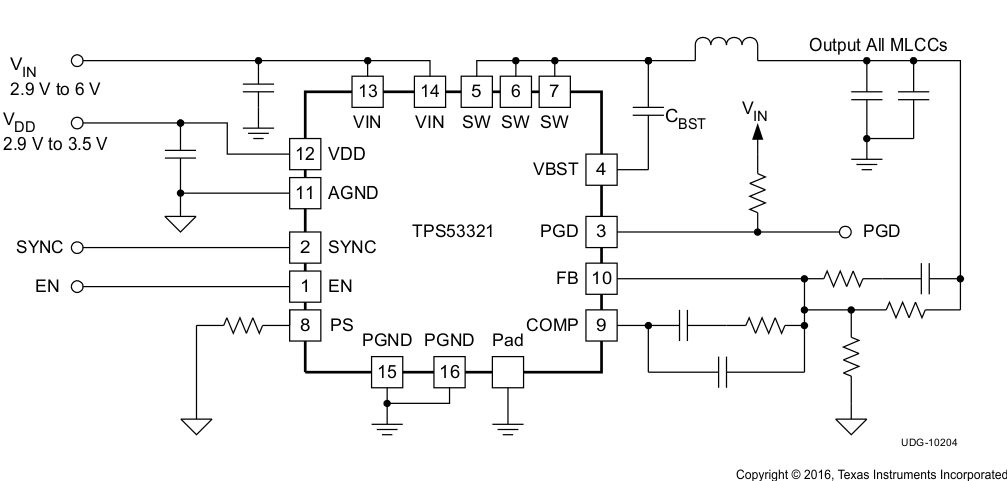SLUSAF3A December 2010 – November 2016 TPS53321
PRODUCTION DATA.
- 1 Features
- 2 Applications
- 3 Description
- 4 Revision History
- 5 Pin Configuration and Functions
- 6 Specifications
- 7 Detailed Description
- 8 Application and Implementation
- 9 Power Supply Recommendations
- 10Layout
- 11Device and Documentation Support
- 12Mechanical, Packaging, and Orderable Information
Package Options
Mechanical Data (Package|Pins)
- RGT|16
Thermal pad, mechanical data (Package|Pins)
- RGT|16
Orderable Information
1 Features
- 96% Maximum Efficiency
- Continuous 5-A Output Current
- Supports All MLCC Output Capacitor
- SmoothPWM™ Auto-Skip Eco-Mode™ for Light-Load Efficiency
- Optimized Efficiency at Light and Heavy Loads
- Voltage Mode Control
- Supports Master-Slave Interleaved Operation
- Synchronization up to ±20% of Nominal Frequency
- Conversion Voltage Range Between 2.9 V and
6 V - Soft-Stop Output Discharge During Disable
- Adjustable Output Voltage Ranging Between
0.6 V and 0.84 V × VIN - Overcurrent, Overvoltage, and Overtemperature Protection
- Small 3 mm × 3 mm, 16-Pin QFN Package
- Open-Drain Power Good Indication
- Internal Boot Strap Switch
- Low RDS(on), 24 mΩ With 3.3-V Input and 19-mΩ With 5-V Input
- Supports Prebias Start-Up
2 Applications
- 5-V Step-Down Rails
- 3.3-V Step-Down Rails
3 Description
The TPS53321 device provides a fully integrated 3-V to 5-V VIN integrated synchronous FET converter solution with 16 total components in 200 mm2 of PCB area. Due to the low ON-resistance and TI's Proprietary SmoothPWM™ skip mode of operation, it enables 96% peak efficiency and over 90% efficiency at loads as light as 100 mA. It requires only two 22-µF ceramic output capacitors for a power dense 5-A solution.
The TPS53321 features a 1.1-MHz switching frequency, skip mode operation support, prebias start-up, internal soft start, output soft discharge, internal VBST switch, power good, EN/input UVLO, overcurrent, overvoltage, undervoltage, and overtemperature protections, and all ceramic output capacitor support. It supports supply voltage from
2.9 V to 3.5 V and conversion voltage from 2.9 V to
6 V. The output voltage is adjustable from 0.6 V to
0.84 V × VIN.
The TPS53321 is available in the 3 mm × 3 mm
16-pin QFN package (Green RoHs compliant and Pb free) and operates between –40°C and 85°C.
Device Information(1)
| PART NUMBER | PACKAGE | BODY SIZE (NOM) |
|---|---|---|
| TPS53321 | QFN (16) | 3.00 mm × 3.00 mm |
- For all available packages, see the orderable addendum at the end of the data sheet.
Typical Application Circuit
